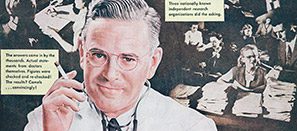The Dark Tactics of Big Tobacco: Unveiling Their Targeting Strategies
Over the last century, tobacco has evolved into a multi-billion-dollar industry. Tobacco companies spend more than $8.06 billion a year marketing their products, and today’s marketing laws have led to new, deceptive advertising tactics with Big Tobacco targeting everyone they can get their hands on.

The Deceptive History of Tobacco Ads
Big Tobacco has a long history of promoting glamor and success through smoking. They’ve used everything from celebrity endorsements to kid-friendly mascots to promote tobacco. When health concerns cut into profits, tobacco companies hired doctors and dentists to manipulate the public perception of cigarettes.
Now, tobacco companies have adopted new products, such as vapes and pouches, as the latest marketing frontier.
Who Does Big Tobacco Target?
Big Tobacco Targeting Kids’ Interests
Over 9 out of 10 adult smokers start before age 18 — thanks to the tobacco industry’s clever, and deceptive, marketing. Advertisements by Big Tobacco targeting minors are used to secure the next generation of customers. That’s why tobacco companies make candy-colored packaging and fruit-flavored products — they know what kids like.
“It’s a well-known fact that teenagers like sweet products.”
— Tobacco Company Internal Memo
Menthol flavoring is also a big problem. Because menthol cigarettes are less harsh and marketed as a smoother alternative, they’re easier for everyone to start — especially teens.
Vapes have been around for years but are still new to the industry. A product that was once thought of as a cessation device has now become an accessible tool to get teens addicted to nicotine. Vapes come in thousands of different flavors — from fruit and candy to decadent desserts and “make-believe” names — and this unethical tactic increases teens’ risk for future smoking.
Big Tobacco Targeting Women’s’ Rights and Insecurities
Starting in the 1920s, tobacco companies began tying their products to the ideas of women’s equality, freedom and body image. Cigarette advertising included slogans like “Reach for a Lucky Instead of a Sweet,” pushing cigarettes as appetite suppressants. Big Tobacco targeting women for their insecurities is especially sinister considering the health effects associated with smoking.
In the 1960s, tobacco companies co-opted the women’s rights movement. They embedded themselves in freedom demonstrations and developed cigarettes designed solely for women, Virginia Slims, and they were successful. Between 1960 and 1990, lung cancer deaths among women increased by more than 400%, according to National Jewish Health.
To further garner female smokers, cigarette companies developed super-slim cigarette packs designed to fit in purses. More recently, R.J. Reynolds Tobacco Company introduced its Camel No. 9 cigarettes, which come in a pink package with the slogan “Light and luscious.” Marketing strategies from Big Tobacco targeting women often promote their products with a variety of handbags, jewelry and female-centric consumer items.
Big Tobacco Targeting Minorities’ Experiences
In the 1960s, the tobacco company Brown and Williamson developed the Kool brand of cigarettes, specifically targeting the Black American community by exploiting the “Black experience.” These tactics have stuck around since. Today, Kools and other menthols are still extremely popular among Black Americans.
Smoking rates in Black American communities remain much higher than those of the general population, and quitting rates are lower. A 2007 study by the American Lung Association found that majority-Black neighborhoods had 2.6 times as many cigarette ads per capita as other neighborhoods.
“We don’t smoke that s___. We just sell it. We reserve the right to smoke for the young, the poor, the black and stupid.”
– R.J. Reynolds Tobacco Company Executive
Tobacco companies have also employed predatory marketing tactics toward Native American communities. Brands such as American Spirit overtly exploit Native American names and imagery to appeal to this demographic. Tobacco companies also exploit sacred use and the spiritual significance of tobacco in Native American practices.
Big Tobacco Targeting With Low Prices and Deals
Big Tobacco extends its grip behind the register, targeting low-income households through discounts and deals. In 2022 alone, tobacco companies spent over $6.5 billion on discounting practices to make cigarettes and tobacco products more affordable. This spending is disproportionately focused on low-income communities, often near schools, exposing kids, teens and other vulnerable groups to constant tobacco marketing.
This tactic has led to:
- More than a quarter of Americans below the poverty line smoking
- A lower quit-success rate for low-income Americans
- Blue-collar workers being more likely to suffer tobacco-related health conditions
The tobacco industry doesn’t care how much they need to spend if their unethical marketing and tobacco targeting methods can get you hooked.
Big Tobacco Targeting Military Personnel
During WWI, WWII, the Korean War and the Vietnam War, U.S. soldiers received free cigarettes, often as part of their rations. Soldiers who survived these conflicts were frequently left to deal with tobacco-related addiction and disease. Despite a Department of Defense ban on the practice, U.S. military personnel continued to receive free tobacco products during the 1990s and 2000s.
The Master Settlement Agreement ended all collaboration between the tobacco industry and the U.S. military. However, after decades of Big Tobacco targeting military personnel, a military culture of smoking still exists today. In 2005, the smoking rate of military personnel was just over 32%, much higher than the civilian rate of 21%. With that comes millions of lost dollars in direct health care costs and lost productivity among active-duty personnel.
Big Tobacco Targeting LGBTQ+ Communities
Tobacco companies have marketed sexually ambiguous and sexually coded messages to LGBTQ+ communities for years. They’ve donated to community events and organizations while sponsoring HIV/AIDS-related charities. The irony couldn’t be greater.
Because of the industry’s tobacco targeting techniques, LGBTQ+ individuals are 40-70% more likely to smoke than non-LGBTQ+ individuals. Also, because other marketers have historically ignored the community, many LGBTQ+ individuals feel an especially strong brand loyalty to their preferred brand of cigarettes.
Marketing and Advertising Tactics
Print and Media Advertising
Do slogans like “More Doctors Smoke Camels” and “Just What the Doctor Ordered” sound familiar? Those are from famous print ads tobacco companies have run in magazines and newspapers over the past decades. Because tobacco advertising laws are so strict, print is one of the few mediums open to the tobacco industry, and they take advantage of that.
Sponsorships and Event Marketing
Big Tobacco targeting doesn’t stop on the page. Popular sporting events were sponsored by tobacco companies for decades. R.J. Reynolds sponsored NASCAR’s Winston Cup for 30 years, which is named after their Winston cigarette brand. Even after regulations prohibited this type of sponsorship, tobacco companies still distribute free products through booths at music festivals and other events.
Digital Marketing
Big Tobacco may not be able to overtly advertise on television, however product placement in TV shows, movies and music videos is still on the table. They’ve put cigarettes in our video games and partner with content creators to fill our apps and phones with subtle tobacco imagery. One of their favorite lies on these mediums is to tout the “benefits” of tobacco and nicotine on mental health — an absolute lie. The tobacco industry will use every tactic to shove itself down our throats. Don’t let it work.
Discover the dark evolution of tobacco marketing.











